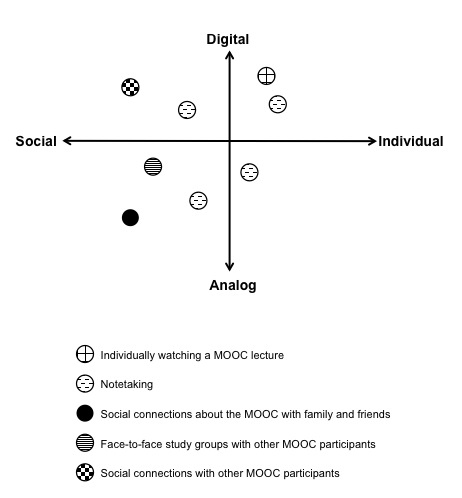The op-ed below first appeared on Inside Higher Ed. This is a first glimpse of a partnership with HarvardX intended to examine learners’ experiences in open courses.
The Invisible Learners Taking MOOCs
“Anyone, anywhere, at any point in time will be able to take advantage of high quality education.”
That could be a tagline from just about any enthusiast or provider of open online courses (often called MOOCs). The intention certainly seems laudable and, if not transformational, at least desirable.
What are the caveats?
Recent research suggests that the majority of people enrolled in these open online courses are highly educated. As far as US participants are concerned, a large percentage also live in high-income neighborhoods.
And yet, despite the extensive research and data on open online courses, we really do not know much about these millions of learners engaged in everything from courses on computer science to poetry to physiotherapy to gender studies to bioinformatics.
In fact, apart from a few anecdotes of extraordinary individuals who overcome insurmountable struggles to succeed (e.g., the exceptional Nigerian man who completed 250 courses) or abstract descriptions of learners and their activity (e.g., “less than 10% complete courses,” “auditors,” or “latecomers”) these learners might as well be invisible.
And thus, my fellow researchers and I are asking more questions. We want to better understand open courses and their learners (and their successes and their failures). How do these people experience open courses? Why they do they things that they do in these courses?
We are currently in the midst of conducting the largest series of interview studies in open courses, and we have just released our first study. Our research is motivated by the fact that very few commentators and researchers to date have paused to talk to learners and to listen to them describe their experiences and activities.
In fact, what researchers know about MOOCs is largely the result of analyzing the data trails that learners leave behind as they navigate digital learning environments.
So far we have interviewed more than 70 individuals who have completed a range of MOOCs. Three of our initial findings question the initial excitement that surrounded MOOCs and contradict the initial hope that these types of courses can help anyone, anywhere, at any point in time to succeed.
Successful online learners have sophisticated study skills. For example, nearly every individual that we have interviewed described his or her notetaking strategies. Learners described how they combine notes across multiple courses and how they arrange notes in order to use them in their exams or future studies.
Learners also described an array of strategies to deal with unfamiliar content, such as using resources external to MOOCs to clarify their understanding of what they learned.
Bjorn, one of the learners we interviewed, reported watching all lecture videos twice. He said: “I read an article about how priming really helps the mind cement content.” And then he applied that insight to his studies: “Instead of watching the videos and taking notes and pausing constantly,” he “watched the video in fast speed first, just really concentrating on the content, and then afterwards, watched it through while taking notes.” This strategy was aimed at improving the processing of new information and demonstrates the sophistication with which some learners approach studying.
Such complex approaches to studying are neither innate nor universal, and throw a cast of doubt over the claim that “anyone” can equally participate in and benefit from these courses.
Flexibility and a flexible life are often essential for engaged participation. A significant proportion of the learners we interviewed either live flexible lives that enable them to participate or appear to be exceptional in their abilities to create time to participate in these courses.
Individuals that live flexible lives are often retirees who frequently tell us that they have time available to explore topics that interest them. Numerous others shared with us that they create time to participate.
For example, a British engineer goes to work an hour earlier every morning in order to work on MOOCs, and an American mother watches MOOC videos when she is not busy caring for her newborn.
Personal and professional circumstances structure the ways that people participate in MOOCs. And here is the conundrum: While online learning experiences can generally be more flexible than face-to-face ones, time is a limited resource, and the individuals who have the privilege of time and flexibility are not necessarily the ones that the quest for the democratization of education via MOOCs aspired to serve.
Online learning is an emotional experience. Somewhere between enrollment numbers, statistics describing completion rates, and the fascination with big data, we forgot that learning experiences are deeply emotional.
Anxiety, appreciation, embarrassment, and pleasure are some of the emotions that learners used to describe their experience in these courses to us.
One of our interviewees, Maria, lives in Greece and works for the public sector. She was “pleasantly surprised” with her experience, especially because she “never thought [she] would be able to study the subject.” She continued: “The most important thing for me is that I can actually learn about the things I have wanted to learn about ever since I was a child. It’s really a dream come true. I will never be able to use it for work or I will never be able to change my profession under the circumstances right now – but I really like and I really want to learn about astronomy and cosmology just for the – just for the joy of it. And that’s why I am going to keep on taking classes.”
Understanding why learners had these emotions is significant in improving digital learning initiatives. More importantly, innovation that lacks care and appreciation for the human condition is not an aspirational strategy to get behind for a bright future.
Now what?
Our research is providing a better understanding of open online learning and the learners that participate in such endeavors. We are finding that the democratization of education and knowledge are noble goals, but free access to content can only go so far in eliminating societal and global inequities.
What’s the value of a course that features high completion rates but perpetuates gender stereotypes?
What’s the value of a course that is freely available but cannot be accessed by people in remote areas of East Texas or remote areas of British Columbia because of language or technological barriers?
Alternatively, isn’t a course that helps people explore their passions desirable, even if only a small minority participate for the duration of it?
We’ve interviewed learners in Australia, Canada, El Salvador, France, Greece, India, Ireland, the Netherlands, Puerto Rico, the United Kingdom, and the United States. These individuals are not mere statistics to which phrases like “any” “always” and “anywhere” can apply.
Ultimately, our research calls into question whether open courses, in their current form, are the democratizing forces they are sometimes depicted to be—and even whether “educating a billion” with MOOCs is a laudable goal.
By getting to know these invisible learners, we think we can build a better foundation for online learning, the design of digital learning experiences, and the use of technology in education. It is already clear from our initial interviews that in order to create more egalitarian structures for education, we need to start peeling away the multitude of barriers that prevent the most vulnerable populations from participating. And that’s a good goal for all of us who care about learning, teaching, and education.
Acknowledgements: Numerous colleagues, research associates, and students contributed to the research reported here, including: Amy Collier (Stanford), Emily Schneider (Stanford), Peter Shepherdson (University of Zurich), Laura Pasquini (Royal Roads University), and Rich McCue (University of Victoria & Royal Roads University). Special thanks to Justin Reich and Rebecca Petersen (Harvard University) and the rest of the HarvardX research team.



